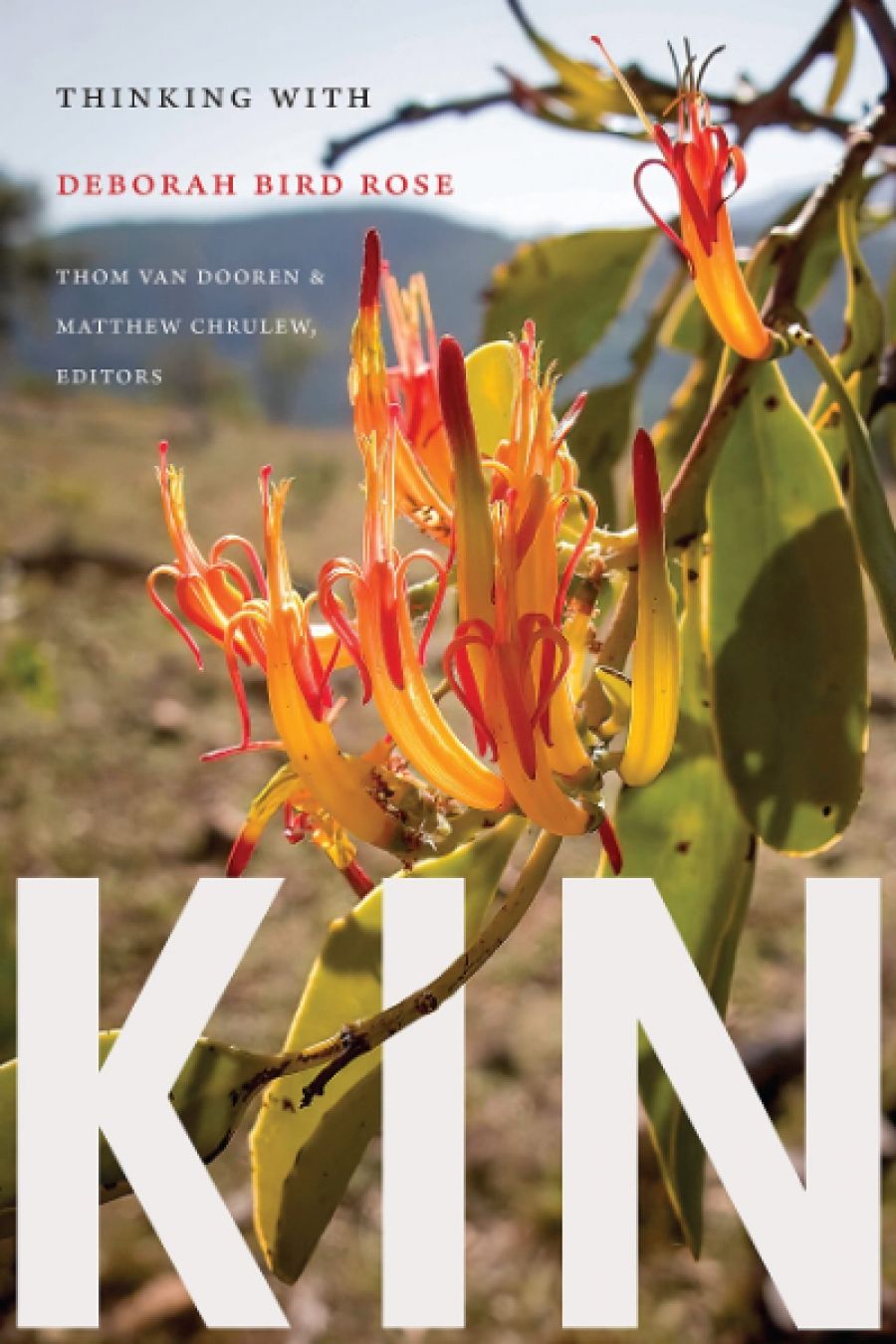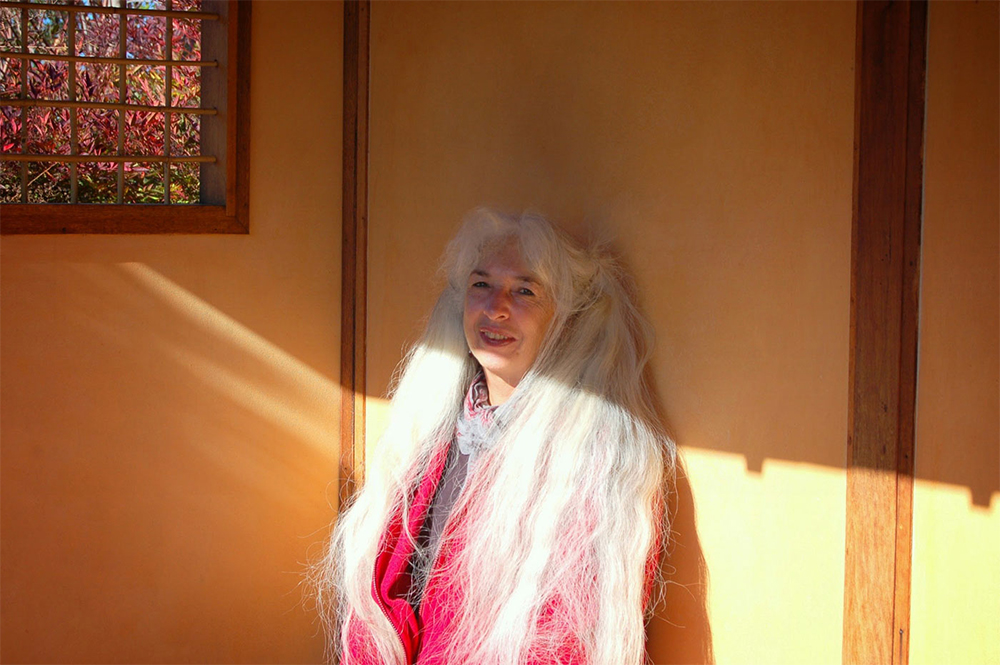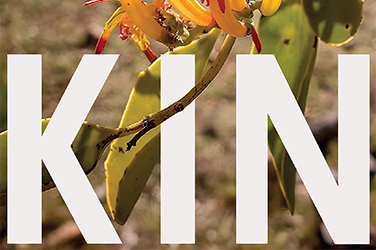
- Free Article: No
- Contents Category: Anthropology
- Review Article: Yes
- Article Title: The world deanimated
- Article Subtitle: Inter-species attention in an age of extinction
- Online Only: No
- Custom Highlight Text:
Deborah Bird Rose (1946–2018) was an interdisciplinary thinker who helped establish the field of the environmental humanities (or ecological humanities); in 2012 she also co-founded the scholarly journal Environmental Humanities. Having initially trained in anthropology, Rose strove to push that field and other ethnographic studies beyond their stubborn anthropocentrism. She came to Australia in 1980 from Bryn Mawr College, Pennsylvania, to undertake PhD research in Aboriginal Australia. Her thinking was shaped by the decades she spent with Aboriginal mentors and friends, in the Northern Territory communities of Lingara and Yarralin. Across her writing, in books such as Wild Dog Dreaming: Love and extinction (2011) and Nourishing Terrains: Australian Aboriginal views of landscape and wilderness (1996), Rose demonstrated and promoted attentiveness to, and ethical engagement with, the plethora of beings on Earth.
- Article Hero Image (920px wide):

- Article Hero Image Caption: Deborah Rose Bird (photograph via Centre for Environmental History)
- Alt Tag (Article Hero Image): Deborah Rose Bird (photograph via Centre for Environmental History)
- Featured Image (400px * 250px):

- Alt Tag (Featured Image): Prithvi Varatharajan reviews 'Kin: Thinking with Deborah Bird Rose' edited by Thom van Dooren and Matthew Chrulew
- Book 1 Title: Kin
- Book 1 Subtitle: Thinking with Deborah Bird Rose
- Book 1 Biblio: Duke University Press, US$25.95 pb, 239 pp
- Book 1 Readings Link: booktopia.kh4ffx.net/gbEy3X
The essays in Kin form a tribute to Rose’s writing and advance her conceptual frameworks. Though kinship is a theme throughout, the book takes its name most directly from an essay contributed by the Bawaka Collective, an Indigenous and non-Indigenous, ‘more-than-human’ research group (David Abram coined ‘more-than-human’ in his 1996 book The Spell of the Sensuous; the term draws its meaning from early European accounts of Indigenous cultures’ connections with the non-human world, and aims to unsettle Western anthropocentrism). The essay uses the Yolŋu term ‘gurruṯu’ to speak of a web of relations; they write: ‘Gurruṯu is the way we are related to one another and to everything … [it] positions us, but it does not suggest a conflation of difference, does not let mother become daughter; rather, it honors our connected kinship as it lives the cyclical relationality of our existence’. I noted that this cyclical ‘relationality’ is represented within the essay, with the following refrain repeated almost identically eight pages apart: ‘For Yolŋu, even though someone may have passed away a long time ago, they are still alive.’ Their ‘Ending with the Wind, Crying the Dawn’ is a moving and lyrical tribute to Rose; it speaks not only of their mutual respect, but vividly evokes the ‘milkarri’ or ‘songspirals’ cried and keened by Yolŋu women – within which, they write, Rose has a continuing place.
What is the value of writing, even writing as complex as this, when species extinctions are accelerating, and settler cultures continue their evisceration of the earth in the name of progress, or of short-term survival? Should we not act, instead of writing? On this subject, Thom van Dooren notes that Rose ‘insisted that storytelling in the mode of bearing witness was a vital responsibility. To refuse to turn away, she argued, was “to remain true to the lives within which ours are entangled, whether or not we can accomplish great change”.’
The Bawaka Collective provide another reply, in speaking of the world-making quality of storytelling: ‘Our lives and deaths keep the songspirals alive. And the songspirals keep us alive too. Learning and singing and keening and crying – these keep Country alive too.’ A further function of storytelling, which Kin aptly demonstrates, is its ability to defamiliarise our industrial world, which tends to render banal, or to ‘naturalise’, the ‘earth-shattering violence’ (Kate Wright, in this collection) of techno-capitalist societies.
James Hatley, in his essay on the near-extermination of Buffalo in the state of Montana, memorably calls extinctions a ‘deanimation of world’, referring to the fact that they do not occur in isolation but have catastrophic effects on all beings with which a species is entwined. ‘What begins as Buffalo genocide culminates in prairie ecocide,’ he writes. ‘Deanimation of world’ is itself an elaboration on a thought by van Dooren: that anthropogenic extinction does not have the precision of a surgeon’s scalpel, ‘excising one creature from among the many’, but instead is like ‘a dull knife tearing at and shredding the multiple threads of entanglement by which a living kind has previously both sustained its world and been sustained by it’. Likely intensifying Rose’s notion of a ‘double death’ – where ‘the dead are left with no living descendants’ – Hatley builds up to describing a ‘Regime of Harrowing’ in Montana:
The doubling of the harrowing of this land, that in its very harrowing it is rendered harrowing, turns out to be not simply a metaphor or a poetic trope, a quick turn of phrase; it’s also an earthly condition, one with teeth in it, teeth of metal … where vast congregations of Buffalo once roamed the prairie and now wheat fields stretch out in every direction.
Hatley’s is one of several essays in Kin that pay sustained attention to a specific situation concerning non-human life. In doing so, they yield keen insights or arguments that are broadly relevant to inter-species relationships, to histories of such, or to settler cultures’ assaults on the environments that sustain them. Other examples in Kin are van Dooren’s essay on the many species of snails that have become, or are on the brink of becoming, extinct in Hawaii; Kate Rigby and Owain Jones’s essay on ‘roadkill’ in Canberra; Anna Lowenhaupt Tsing’s essay on the socially complex, colonially inflected activity of bird watching on the island of Waigeo near West Papua; and Catriona Sandilands’s hybrid poem–essay on ‘Scotch broom’, an ‘exotic-invasive species’ of plant in the southern coastal region of British Columbia.
The most theoretical or conceptually dense, and in this case rewarding, contribution is Isabelle Stengers’ ‘Awakening to the Call of Others: What I learned from existential ecology’. Her essay probes the idea of an objective, disinterested ‘Science’ and its exploitative relationships with its subjects, in contrast to interested, ‘entrepreneurial’ scientific practices that might accommodate a more-than-human ‘cosmopolitics’. Another theoretical essay, Stephen Muecke’s ‘After Nature: Totemism revisited’, argues alongside Rose that for Aboriginal peoples, totemism – which was often mocked by modern European cultures – ‘was no arbitrary or symbolic set of beliefs but was a real system in place in multiple-universe societies’. Muecke critiques the artificial division between (human) ‘culture’ and an undifferentiated ‘nature’ – an ontological split he argues derives from the Enlightenment, and which has unfortunately had enduring effects in European and settler societies.
At one point, I started noting down neo-compound words in the collection: ‘lifedeath’; ‘pastpresents’; ‘natureculture’; ‘technoculture’; ‘deathzone’, etc. Some of these (e.g. ‘deathzone’) were used by Rose, while others have been coined in her spirit to better describe a reality. They are particularly concentrated in Donna Haraway’s excellent essay, which uses Patricia Piccinini’s ‘technocultural’ works of art to reflect on species endangerment and responsibility in the hyper-technologised present. ‘Living endangered means living in technoculture; it is the condition of flourishing – or not – on Earth now for most critters,’ Haraway writes. ‘Living well in technoculture is part of the obligation of taking care of unexpected country.’
Kin has inspired me to read back through Rose’s body of work. While it is clearly a boon to environmental humanities scholarship, there is a need for rigorous publications like this – which incrementally elaborate the ‘relational ethics’ that are possible between humans and non-humans (Rose) – for a non-scholarly audience. I hope that, as thinkers continue their imaginative dialogues with Rose, they are able to reach out to others, and in turn find more and more hands willing to meet theirs.


Comments powered by CComment